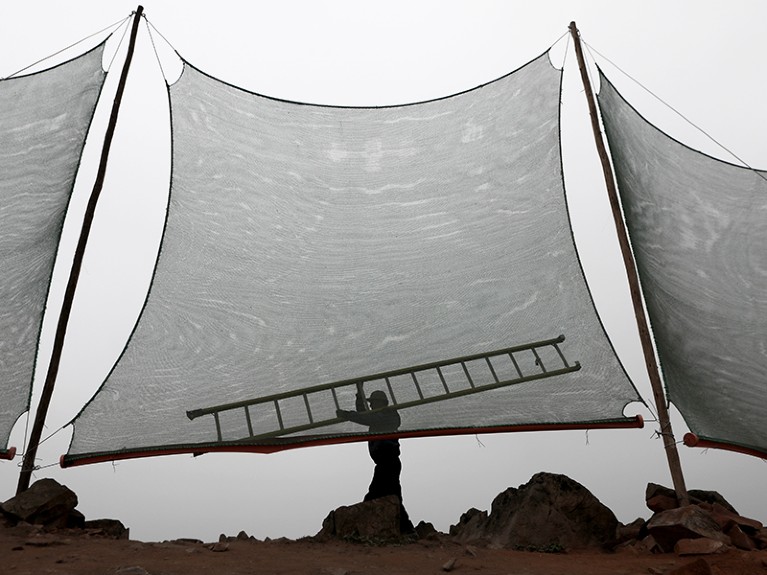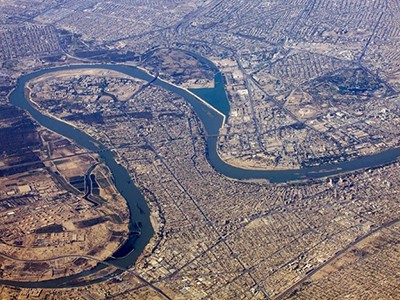
Fog-catching nets (seen here in Lima) can collect enough water for daily use. This technology has the potential to be used on larger scales.Credit: Klebher Vasquez/Anadolu Agency/Getty
This year’s United Nations water conference — the first in nearly 50 years — did not lead to a binding agreement. But the event, held in March in New York City, provided a wake-up call: water crises are worsening and need our urgent attention.
As of last year, some 2.2 billion people still lacked access to safe drinking water, according to a July report from the World Health Organization and the UN children’s agency UNICEF (see go.nature.com/3djb6tb). And some 653 million people did not have hand-washing facilities at home.
Fixing these problems is among the targets of the sixth of the UN Sustainable Development Goals (SDGs): to “ensure availability and sustainable management of water and sanitation for all” by 2030. This editorial is part of Nature’s series looking at each of the SDGs, set in 2015, at their halfway stage. We are focusing on questions and gaps that researchers can help to address.
Progress towards the Sustainable Development Goals
When the SDGs launched, there was optimism that the water goal could be reached, and progress has been made on some of its targets. Since 2000, an extra 2 billion people have gained access to safe drinking water, and by 2020, some 56% of all households had their waste water treated.
But overall progress has not been fast enough, and, as early as 2018, UN-Water, which coordinates the UN’s work on water and sanitation, warned that the world was not on track. Countries are not prioritizing this goal, either at the national or the global level. By the UN’s own estimates, to achieve SDG 6, the world will need to spend US$260 billion per year by 2030 — mostly in Asia and Africa, where the numbers of people without safe drinking water are highest. International development assistance for water-related projects is currently around $9 billion annually, and has been falling since 2017. When there’s no policy strategy, it becomes hard to demonstrate research or pilot projects on large scales. Yet that is what needs to happen if clean water and sanitation are to become universal.
Generations of water-stressed communities have applied the results of knowledge and innovation to get water. But there has been, at best, partial success for attempts to systematically share techniques that are known to work on local scales, such as condensing water from clouds with giant nets, used in Chile and Peru, or storing snow for use in dry periods, as practised in parts of China.
It’s the same for newer technologies. For example, membrane distillation is a low-temperature method of desalinating water. It’s greener than existing methods because it uses less electricity, as chemical engineer Mohammed Rasool Qtaishat at the University of Jordan and his colleagues reported last year1. However, it is struggling to break out of the research and pilot phases and be deployed at larger scales. In a study2 published in March, Patricia Gorgojo, a chemical engineer at the University of Zaragoza, Spain, and her colleagues recommend improving communication between those who undertake small-scale studies and those who implement larger-scale demonstration projects, because the two often have different needs.
Global action on water: less rhetoric and more science
When it comes to research in its broader sense, results can be scaled up, as medical anthropologist Sera Young and her team at Northwestern University in Evanston, Illinois, show3,4. They have developed inclusive measures of the experience of being water-stressed, called water insecurity experiences (WISE) scales.
SDG 6’s sanitation target calls for “special attention to the needs of women and girls”. But the UN’s annual progress reports do not include data on this topic. The principal reason seems to be that surveys are typically conducted at the household level — rather than at the individual level — and therefore cannot be disaggregated by sex or gender. This is where the WISE scales are effective: they can collect data at the household or individual level. They examine how water insecurity affects daily activities, health and well-being, from cooking, hand washing and laundry to personal hygiene and feelings of anger and anxiety. Respondents are identified according to age, gender and income, among other characteristics.
The WISE scales are being used by some 100 national, intergovernmental, research and civil-society organizations around the world. Their use as a policy tool was demonstrated last year in Australia, which officially, has relatively low levels of water insecurity, with just 1% of the population affected. But some communities don’t recognize this picture. In 2022, Yuwaya Ngarra-li, a partnership between the Dharriwaa Elders Group — an Aboriginal cultural organization in the rural town of Walgett — and the University of New South Wales in Sydney applied the WISE methodology to a survey of 251 people and found that around 44% of respondents reported water insecurity and 46% food insecurity (see go.nature.com/3dciovf). The communities and Walgett Shire Council are exploring how to bring about improvements.
As the world gets closer to the 2030 SDG deadline, more ideas will undoubtedly emerge, with promising potential. But SDG 6 will not be achieved without attention to scale. This is a large missing piece of the water and sanitation jigsaw. Ultimately, implementation is what matters.

 Progress towards the Sustainable Development Goals
Progress towards the Sustainable Development Goals
 The world faces a water crisis — 4 powerful charts show how
The world faces a water crisis — 4 powerful charts show how
 Global action on water: less rhetoric and more science
Global action on water: less rhetoric and more science




